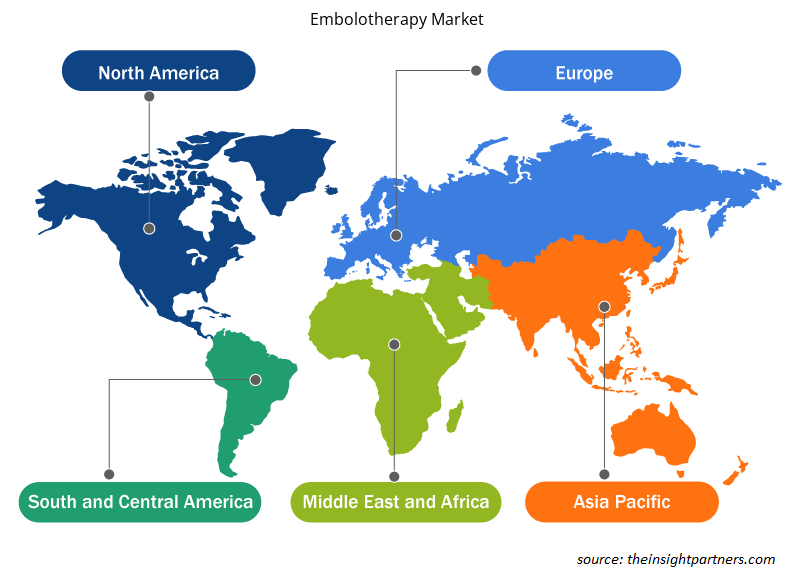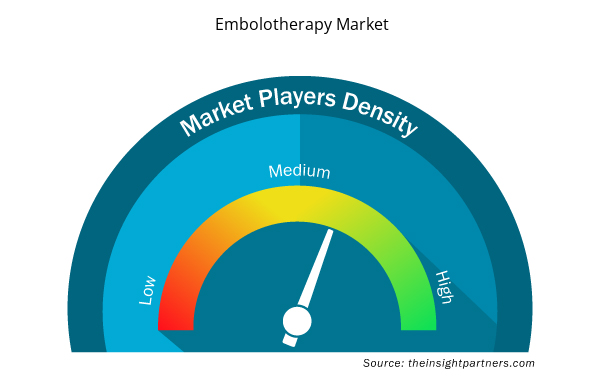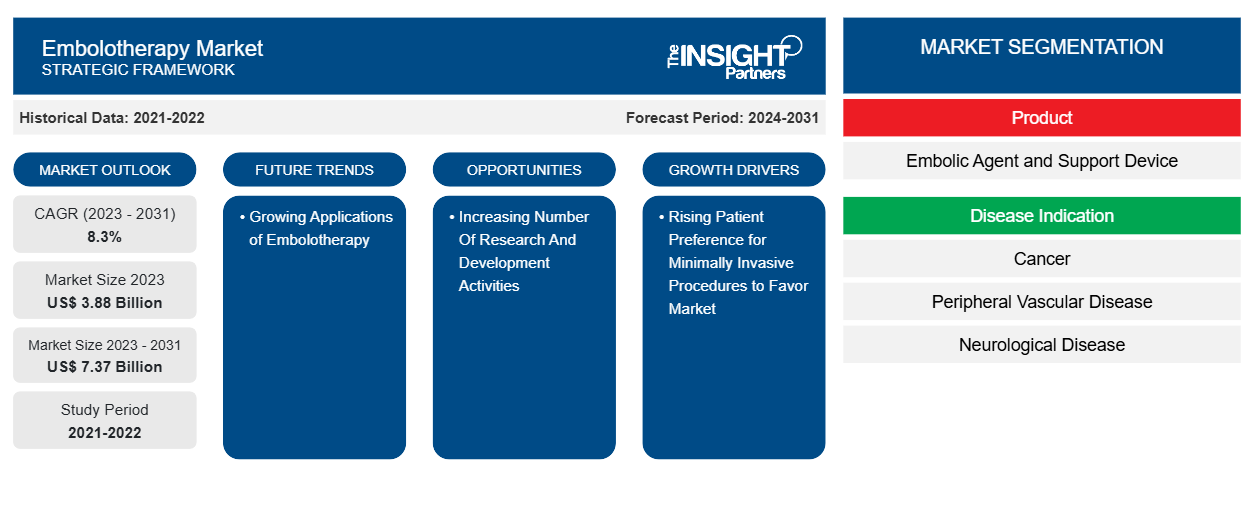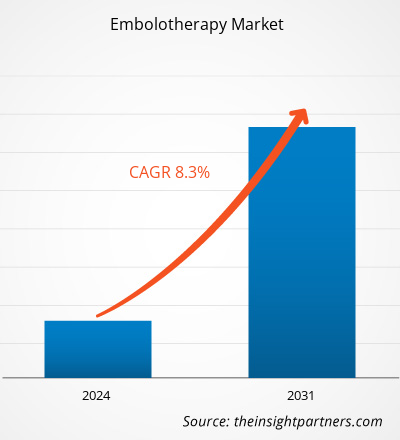Der Markt für Embolotherapien soll von 3,88 Milliarden US-Dollar im Jahr 2023 auf 7,37 Milliarden US-Dollar im Jahr 2031 anwachsen. Für den Zeitraum 2023–2031 wird ein durchschnittliches jährliches Wachstum von 8,3 % erwartet. Der zunehmende Einsatz flüssiger Emboliemittel dürfte ein wichtiger Trend auf dem Markt bleiben.
Embolotherapie-Marktanalyse
In Europa und weltweit ist eine steigende Zahl von Schlaganfällen und Aneurysmen zu beobachten. In Spanien beispielsweise gilt der Schlaganfall nach der Alzheimer-Krankheit und dem ischämischen Schlaganfall als dritthäufigste Todesursache. In Afrika ist Bluthochdruck neben anderen Risikofaktoren wie Fettleibigkeit, Stress, Rauchen, Alkoholkonsum, körperlicher Inaktivität und ungesunder Ernährung der Hauptrisikofaktor für Schlaganfälle. Im Jahr 2020 wurden in Südafrika außerdem 111.321 neue Krebsfälle diagnostiziert, und es gab im Land mehr als 64.547 krebsbedingte Todesfälle. Aufgrund der oben genannten Faktoren führen viele Organisationen Programme durch, um die Sterblichkeitsrate aufgrund chronischer Krankheiten zu senken . So wurde beispielsweise das Healthy Heart Africa (HHA)-Programm von AstraZeneca ins Leben gerufen, um Bluthochdruck vorzubeugen und die zunehmende Belastung durch Herz-Kreislauf-Erkrankungen in ganz Afrika zu verringern.
Embolotherapie-Marktübersicht
Die zunehmende Implementierung der Embolotherapie zur Behandlung von endovaskulären Erkrankungen, traumatischen Verletzungen, zerebrovaskulären Missbildungen, venösen Missbildungen, arteriovenösen Missbildungen und pädiatrischen Gefäßerkrankungen dürfte in den kommenden Jahren Chancen für Umsatzwachstum im Embolotherapiemarkt bieten. Die Prävalenz von Hirnaneurysmen in Kanada steigt. Laut der Brain Aneurysm Foundation erleiden jedes Jahr etwa 2.800 bis 3.500 Menschen ein Hirnaneurysma, was etwa 3 % aller hämorrhagischen Schlaganfälle ausmacht. Darüber hinaus wird die Prävalenz bei Menschen über 40 Jahren beobachtet. Laut dem Canadian Institute for Health Information wird die Bevölkerung im Alter von 65 Jahren in den nächsten 20 Jahren voraussichtlich um 68 % wachsen. Laut der Brain Injury Association erleiden jedes Jahr etwa 160.000 Kanadier eine erworbene Hirnverletzung. Diese Zahlen steigen weiter und erhöhen wahrscheinlich die Wahrscheinlichkeit eines Aneurysmas.
Passen Sie diesen Bericht Ihren Anforderungen an
Sie erhalten kostenlos individuelle Anpassungen an jedem Bericht, einschließlich Teilen dieses Berichts oder einer Analyse auf Länderebene, eines Excel-Datenpakets sowie tolle Angebote und Rabatte für Start-ups und Universitäten.
- Holen Sie sich die wichtigsten Markttrends aus diesem Bericht.Dieses KOSTENLOSE Beispiel umfasst eine Datenanalyse von Markttrends bis hin zu Schätzungen und Prognosen.
Treiber und Chancen auf dem Embolotherapie-Markt
Steigende Patientenpräferenz für minimalinvasive Eingriffe begünstigt den Markt
Von offenen Operationen werden heutzutage weniger Verfahren bevorzugt, sondern minimal-invasive Verfahren mit Echtzeit-Bildgebung. Auch die Prostataarterien-Embolisation (PAE) ist eine minimal-invasive Therapie, die ambulant bei Symptomen des unteren Harntrakts (LUTS) infolge einer benignen Prostatahyperplasie (BPH) durchgeführt wird. In den letzten Jahren ist die Zahl der mit PAE geheilten Patienten gestiegen. Die Embolisation hat sich als minimal-invasive Technik zur Gefäßokklusion etabliert . Flüssige Emboliemittel haben beträchtliche Aufmerksamkeit auf sich gezogen, da sie tief in die Gefäße eindringen und unabhängig von der Thrombusbildung wirken, die vom Gerinnungssystem des Patienten abhängt.
Zunehmende Zahl an Forschungs- und Entwicklungsaktivitäten
Aufgrund der zunehmenden Forschungs- und Entwicklungsaktivitäten wird erwartet, dass neue Produkteinführungen und Innovationen die Einführung neuer Technologien vorantreiben und das Marktwachstum ankurbeln. So hat das koreanische Ministerium für Lebensmittel- und Arzneimittelsicherheit (MFDS) im September 2021 das NUMEN Coil Embolization System und das NUMEN FR Detachment System von MicroPort NeuroTech zugelassen. Für den Einsatz in Krankenhäusern wird NUMEN aufgrund seiner stabilen Embolisation und dichten Packung hauptsächlich bei endovaskulären Coiling-Verfahren zur Behandlung intrakranieller Aneurysmen eingesetzt. Darüber hinaus haben sie auch das NUMEN Coil Embolization System entwickelt, das vom koreanischen Health Insurance Review and Assessment Service (HIRA) als Produkt zugelassen wurde, das in Korea von den Krankenversicherungen erstattet werden kann. Die oben genannten Faktoren werden im Prognosezeitraum wahrscheinlich Chancen für den Embolotherapiemarkt schaffen.
Embolotherapie-Marktbericht – Segmentierungsanalyse
Wichtige Segmente, die zur Ableitung der Embolotherapie-Marktanalyse beigetragen haben, sind Produkt, Krankheitsindikation, Verfahren und Endbenutzer.
- Basierend auf dem Produkt ist der Embolietherapiemarkt in Emboliemittel und Unterstützungsgeräte unterteilt. Darüber hinaus ist das Segment der Emboliemittel in Mikrokugeln, Emboliespiralen, flüssige Emboliemittel, Emboliestopfensysteme, abnehmbare Ballons und andere unterteilt. Außerdem ist das Segment der Unterstützungsgeräte weiter in Mikrokatheter und Führungsdrähte unterteilt. Das Segment der Emboliemittel hatte 2023 einen größeren Marktanteil.
- Basierend auf der Krankheitsindikation ist der Embolotherapiemarkt in Krebs, periphere Gefäßerkrankungen, neurologische Erkrankungen, urologische und nephrologische Erkrankungen, Magen-Darm-Erkrankungen und andere unterteilt. Das Krebssegment hatte im Jahr 2023 einen größeren Marktanteil.
- Basierend auf dem Verfahren ist der Embolotherapiemarkt in transkatheterale arterielle Embolisation (TAE), transkatheterale arterielle Radioembolisation (TARE)/selektive interne Strahlentherapie (SIRT) und transarterielle Chemoembolisation (TACE) unterteilt. Das Segment der transkatheteralen arteriellen Embolisation (TAE) hatte im Jahr 2023 einen größeren Marktanteil.
- Basierend auf dem Endverbraucher ist der Embolotherapiemarkt in Krankenhäuser und Kliniken, ambulante chirurgische Zentren und andere Endverbraucher unterteilt. Das Segment Krankenhäuser und Kliniken hatte im Jahr 2023 einen größeren Marktanteil.
Embolotherapie Marktanteilsanalyse nach Geografie
Der geografische Umfang des Embolotherapie-Marktberichts ist hauptsächlich in fünf Regionen unterteilt: Nordamerika, Asien-Pazifik, Europa, Naher Osten und Afrika sowie Süd- und Mittelamerika.
Nordamerika dominiert den Markt und der asiatisch-pazifische Raum wird in den kommenden Jahren voraussichtlich die höchste durchschnittliche jährliche Wachstumsrate aufweisen. Das Wachstum des asiatisch-pazifischen Marktes ist auf die steigende Prävalenz von Schlaganfällen, koronaren Herzkrankheiten, Herzkrankheiten, zunehmenden chirurgischen Eingriffen und anderen zurückzuführen. Der Anstieg der Herz-Kreislauf-Erkrankungen ist auf den Anstieg von Risikofaktoren wie Cholesterin, Blutdruck, Rauchen und Diabetes zurückzuführen. Der Anteil der rauchenden Männer in Japan von 35,4 % ist höher als die Raucherquote in den USA. Darüber hinaus brachte Medtronic im Juni 2022 einen CE-gekennzeichneten Flow Diverter der vierten Generation auf den Markt, ein Pipeline Vantage-Embolisationsgerät mit Shield-Technologie für die endovaskuläre Behandlung von Hirnaneurysmen. Die oben genannten Faktoren werden den Embolotherapiemarkt vorantreiben.
Regionale Einblicke in den Embolotherapie-Markt
Die regionalen Trends und Faktoren, die den Embolotherapie-Markt im Prognosezeitraum beeinflussen, wurden von den Analysten von Insight Partners ausführlich erläutert. In diesem Abschnitt werden auch Embolotherapie-Marktsegmente und -Geografie in Nordamerika, Europa, im asiatisch-pazifischen Raum, im Nahen Osten und Afrika sowie in Süd- und Mittelamerika erörtert.

- Erhalten Sie regionale Daten zum Embolotherapie-Markt
Umfang des Embolotherapie-Marktberichts
| Berichtsattribut | Details |
|---|---|
| Marktgröße im Jahr 2023 | 3,88 Milliarden US-Dollar |
| Marktgröße bis 2031 | 7,37 Milliarden US-Dollar |
| Globale CAGR (2023 - 2031) | 8,3 % |
| Historische Daten | 2021-2022 |
| Prognosezeitraum | 2024–2031 |
| Abgedeckte Segmente | Nach Produkt
|
| Abgedeckte Regionen und Länder | Nordamerika
|
| Marktführer und wichtige Unternehmensprofile |
|
Dichte der Marktteilnehmer im Bereich Embolotherapie: Auswirkungen auf die Geschäftsdynamik verstehen
Der Embolotherapie-Markt wächst rasant, angetrieben durch die steigende Nachfrage der Endnutzer aufgrund von Faktoren wie sich entwickelnden Verbraucherpräferenzen, technologischen Fortschritten und einem größeren Bewusstsein für die Vorteile des Produkts. Mit steigender Nachfrage erweitern Unternehmen ihr Angebot, entwickeln Innovationen, um die Bedürfnisse der Verbraucher zu erfüllen, und nutzen neue Trends, was das Marktwachstum weiter ankurbelt.
Die Marktteilnehmerdichte bezieht sich auf die Verteilung der Firmen oder Unternehmen, die in einem bestimmten Markt oder einer bestimmten Branche tätig sind. Sie gibt an, wie viele Wettbewerber (Marktteilnehmer) in einem bestimmten Marktraum im Verhältnis zu seiner Größe oder seinem gesamten Marktwert präsent sind.
Die wichtigsten auf dem Embolotherapie-Markt tätigen Unternehmen sind:
- Abbott Laboratories
- Boston Scientific ist eine gemeinnützige Organisation, die sich auf die Förderung von Wissenschaft und Technologie spezialisiert hat. Sie ist die erste in den USA und hat 19
- Koch Medical LLC
- Johnson & Johnson Consumer Inc
- Medtronic
- Acandis GmbH
Haftungsausschluss : Die oben aufgeführten Unternehmen sind nicht in einer bestimmten Reihenfolge aufgeführt.

- Überblick über die wichtigsten Akteure auf dem Embolotherapie-Markt
Neuigkeiten und aktuelle Entwicklungen zum Embolotherapie-Markt
Der Embolotherapie-Markt wird durch die Erhebung qualitativer und quantitativer Daten nach Primär- und Sekundärforschung bewertet, die wichtige Unternehmensveröffentlichungen, Verbandsdaten und Datenbanken umfasst. Nachfolgend sind einige der Entwicklungen auf dem Embolotherapie-Markt aufgeführt:
- Terumo Medical Corporation hat die Markteinführung des neuen AZUR HydroPack Peripheral Coil Systems in den USA angekündigt. Diese Spule ist dafür ausgelegt, Hohlräume im Gefäß zu finden und zu füllen. Sie ist die einzige Packspule, die eine proprietäre Hydrogeltechnologie verwendet, um einen Gelkern für die mechanische Okklusion zu erzeugen. (Quelle: Terumo Medical Corporation, Pressemitteilung, Dezember 2023)
- Guerbet kündigte an, dass es sein Angebot an Mikrokathetern verdoppeln und eine neue Linie an Führungsdrähten auf den Markt bringen werde, wodurch ein breites Spektrum an Lösungen für interventionelle Bildgebung und Embolisation verfügbar werde. (Quelle: Guerbet, Pressemitteilung, März 2022)
Umfang und Ergebnisse des Embolotherapie-Marktberichts
Der Bericht „Embolotherapie-Marktgröße und -prognose (2021–2031)“ bietet eine detaillierte Analyse des Marktes, die die folgenden Bereiche abdeckt:
- Embolotherapie-Marktgröße und -prognose auf globaler, regionaler und Länderebene für alle wichtigen Marktsegmente, die im Rahmen des Berichts abgedeckt sind
- Embolotherapie-Markttrends sowie Marktdynamik wie Treiber, Einschränkungen und wichtige Chancen
- Detaillierte PEST/Porters Five Forces- und SWOT-Analyse
- Embolotherapie-Marktanalyse mit wichtigen Markttrends, globalen und regionalen Rahmenbedingungen, wichtigen Akteuren, Vorschriften und aktuellen Marktentwicklungen3
- Branchenlandschaft und Wettbewerbsanalyse, einschließlich Marktkonzentration, Heatmap-Analyse, prominenten Akteuren und aktuellen Entwicklungen für den Embolotherapie-Markt
- Detaillierte Firmenprofile
- Historische Analyse (2 Jahre), Basisjahr, Prognose (7 Jahre) mit CAGR
- PEST- und SWOT-Analyse
- Marktgröße Wert/Volumen – Global, Regional, Land
- Branche und Wettbewerbsumfeld
- Excel-Datensatz



Report Coverage
Revenue forecast, Company Analysis, Industry landscape, Growth factors, and Trends

Segment Covered
This text is related
to segments covered.

Regional Scope
North America, Europe, Asia Pacific, Middle East & Africa, South & Central America

Country Scope
This text is related
to country scope.
Häufig gestellte Fragen
North America has dominated the Embolotherapy market.
Factors such as rising patient preference for minimally invasive procedures and growing application of embolotherapy will boost the market growth.
Increasing use of liquid embolic agents is likely to remain a key trend in the market.
The Embolotherapy market size is projected to reach US$ 7.37 billion by 2031.
The market is expected to register a CAGR of 8.3% during 2023–2031.
Trends and growth analysis reports related to Life Sciences : READ MORE..
The Insight Partners performs research in 4 major stages: Data Collection & Secondary Research, Primary Research, Data Analysis and Data Triangulation & Final Review.
- Data Collection and Secondary Research:
As a market research and consulting firm operating from a decade, we have published and advised several client across the globe. First step for any study will start with an assessment of currently available data and insights from existing reports. Further, historical and current market information is collected from Investor Presentations, Annual Reports, SEC Filings, etc., and other information related to company’s performance and market positioning are gathered from Paid Databases (Factiva, Hoovers, and Reuters) and various other publications available in public domain.
Several associations trade associates, technical forums, institutes, societies and organization are accessed to gain technical as well as market related insights through their publications such as research papers, blogs and press releases related to the studies are referred to get cues about the market. Further, white papers, journals, magazines, and other news articles published in last 3 years are scrutinized and analyzed to understand the current market trends.
- Primary Research:
The primarily interview analysis comprise of data obtained from industry participants interview and answers to survey questions gathered by in-house primary team.
For primary research, interviews are conducted with industry experts/CEOs/Marketing Managers/VPs/Subject Matter Experts from both demand and supply side to get a 360-degree view of the market. The primary team conducts several interviews based on the complexity of the markets to understand the various market trends and dynamics which makes research more credible and precise.
A typical research interview fulfils the following functions:
- Provides first-hand information on the market size, market trends, growth trends, competitive landscape, and outlook
- Validates and strengthens in-house secondary research findings
- Develops the analysis team’s expertise and market understanding
Primary research involves email interactions and telephone interviews for each market, category, segment, and sub-segment across geographies. The participants who typically take part in such a process include, but are not limited to:
- Industry participants: VPs, business development managers, market intelligence managers and national sales managers
- Outside experts: Valuation experts, research analysts and key opinion leaders specializing in the electronics and semiconductor industry.
Below is the breakup of our primary respondents by company, designation, and region:

Once we receive the confirmation from primary research sources or primary respondents, we finalize the base year market estimation and forecast the data as per the macroeconomic and microeconomic factors assessed during data collection.
- Data Analysis:
Once data is validated through both secondary as well as primary respondents, we finalize the market estimations by hypothesis formulation and factor analysis at regional and country level.
- Macro-Economic Factor Analysis:
We analyse macroeconomic indicators such the gross domestic product (GDP), increase in the demand for goods and services across industries, technological advancement, regional economic growth, governmental policies, the influence of COVID-19, PEST analysis, and other aspects. This analysis aids in setting benchmarks for various nations/regions and approximating market splits. Additionally, the general trend of the aforementioned components aid in determining the market's development possibilities.
- Country Level Data:
Various factors that are especially aligned to the country are taken into account to determine the market size for a certain area and country, including the presence of vendors, such as headquarters and offices, the country's GDP, demand patterns, and industry growth. To comprehend the market dynamics for the nation, a number of growth variables, inhibitors, application areas, and current market trends are researched. The aforementioned elements aid in determining the country's overall market's growth potential.
- Company Profile:
The “Table of Contents” is formulated by listing and analyzing more than 25 - 30 companies operating in the market ecosystem across geographies. However, we profile only 10 companies as a standard practice in our syndicate reports. These 10 companies comprise leading, emerging, and regional players. Nonetheless, our analysis is not restricted to the 10 listed companies, we also analyze other companies present in the market to develop a holistic view and understand the prevailing trends. The “Company Profiles” section in the report covers key facts, business description, products & services, financial information, SWOT analysis, and key developments. The financial information presented is extracted from the annual reports and official documents of the publicly listed companies. Upon collecting the information for the sections of respective companies, we verify them via various primary sources and then compile the data in respective company profiles. The company level information helps us in deriving the base number as well as in forecasting the market size.
- Developing Base Number:
Aggregation of sales statistics (2020-2022) and macro-economic factor, and other secondary and primary research insights are utilized to arrive at base number and related market shares for 2022. The data gaps are identified in this step and relevant market data is analyzed, collected from paid primary interviews or databases. On finalizing the base year market size, forecasts are developed on the basis of macro-economic, industry and market growth factors and company level analysis.
- Data Triangulation and Final Review:
The market findings and base year market size calculations are validated from supply as well as demand side. Demand side validations are based on macro-economic factor analysis and benchmarks for respective regions and countries. In case of supply side validations, revenues of major companies are estimated (in case not available) based on industry benchmark, approximate number of employees, product portfolio, and primary interviews revenues are gathered. Further revenue from target product/service segment is assessed to avoid overshooting of market statistics. In case of heavy deviations between supply and demand side values, all thes steps are repeated to achieve synchronization.
We follow an iterative model, wherein we share our research findings with Subject Matter Experts (SME’s) and Key Opinion Leaders (KOLs) until consensus view of the market is not formulated – this model negates any drastic deviation in the opinions of experts. Only validated and universally acceptable research findings are quoted in our reports.
We have important check points that we use to validate our research findings – which we call – data triangulation, where we validate the information, we generate from secondary sources with primary interviews and then we re-validate with our internal data bases and Subject matter experts. This comprehensive model enables us to deliver high quality, reliable data in shortest possible time.


 Holen Sie sich ein kostenloses Muster für diesen Bericht
Holen Sie sich ein kostenloses Muster für diesen Bericht